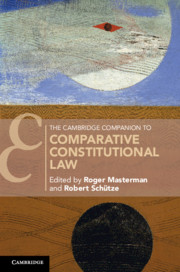Book contents
- Reviews
- The Cambridge Companion to Comparative Constitutional Law
- Cambridge Companions to Law
- The Cambridge Companion toComparative Constitutional Law
- Copyright page
- Contents
- Notes on Contributors
- Acknowledgements
- Table of Cases (Selection)
- Abbreviations
- Introduction
- Part I Theoretical Foundations
- Part II Historical Experiences
- Part III Constitutional Principles
- 8 Democracy
- 9 Separation of Powers
- 10 The Rule of Law
- 11 Human Rights Law
- 12 Federalism
- Part IV State Institutions
- Part V Transnational Constitutionalism
- Index
- References
9 - Separation of Powers
from Part III - Constitutional Principles
Published online by Cambridge University Press: 30 September 2019
- Reviews
- The Cambridge Companion to Comparative Constitutional Law
- Cambridge Companions to Law
- The Cambridge Companion toComparative Constitutional Law
- Copyright page
- Contents
- Notes on Contributors
- Acknowledgements
- Table of Cases (Selection)
- Abbreviations
- Introduction
- Part I Theoretical Foundations
- Part II Historical Experiences
- Part III Constitutional Principles
- 8 Democracy
- 9 Separation of Powers
- 10 The Rule of Law
- 11 Human Rights Law
- 12 Federalism
- Part IV State Institutions
- Part V Transnational Constitutionalism
- Index
- References
Summary
‘Separation of powers’ is a concept that is much used, much criticized, but rarely reflected on in contemporary comparative constitutional law.1 Before it can be discussed properly, we have to elaborate some basic distinctions. Separation of powers can be used as a shorthand description of the organization of government as a whole. Political scientists and lawyers have widely applied the notion in this way even though there is nothing distinctively normative about it. The concept can also serve as a legal argument in constitutional reasoning. Both uses are not mutually exclusive; even though the first does not refer to a normative concept, it seems to be helpful for constitutional lawyers who want to analyse the organizational structure of governments. The second one might also help non-legal researchers to understand one important element of constitutional reasoning and both uses can be intertwined on different levels. The legal argument strives to guarantee a certain organization of government, and it is applied by institutions, namely by courts, which are part of this organization. In the academic debate, both uses are often combined. Especially in the American realist tradition, legal arguments are connected with institutional analyses.2 This is fine, but it should be ensured that the argument remains clear about its claims and keeps both levels not necessarily separated, but distinct. As long as there is a methodological difference between ‘comparative constitutional law’ and ‘comparative government’, this distinction will play a role.3
- Type
- Chapter
- Information
- The Cambridge Companion to Comparative Constitutional Law , pp. 230 - 257Publisher: Cambridge University PressPrint publication year: 2019



